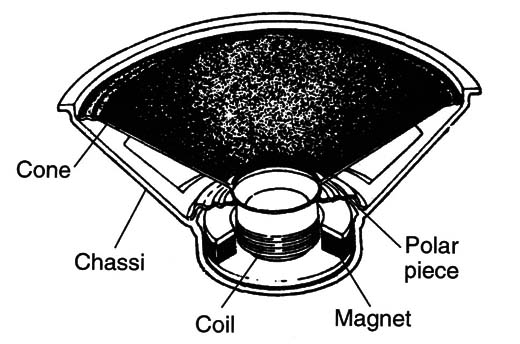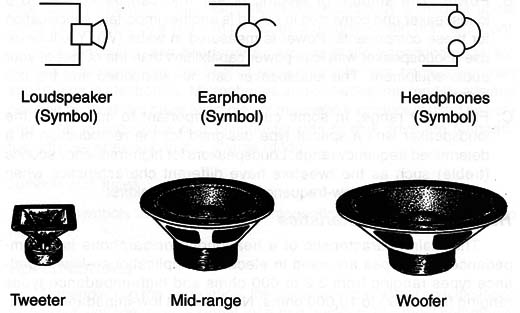The moving coil loudspeaker (the most common in audio applications) is formed by a coil involving a polar metal piece where a strong magnetic field is produced by a magnet as shown in Figure 1.

The coil is fixed in a cardboard or plastic cone. When the signal is applied to the coil, its magnetic field interacts with the magnetic field produced in the polar piece, resulting in a force that moves the coil and the cone fonNard and backward.
Compression and decompression waves are produced in the air surrounding the cone. These waves have a waveform corresponding to the original sound being reproduced.
In magnetic headphones small devices that operate according to the same principle can be found. Remember that both loudspeaker and headphones exist that operate from other principles such as the piezoelectric units. (See more in the site)
Symbols and Types
Figure 2 shows the symbols and the types of some loudspeakers.

The larger the size of a loudspeaker, the easier the production of low-frequency sounds. This means that heavy magnets and large diameters are characteristics of low-frequency loudspeakers, also named bass speakers or woofers.
Small loudspeakers are used for the reproduction of high-frequency sounds. These small speakers are called treble speakers or tweeters.
lt is important to remember that many loudspeakers are designed to operate only inside enclosures.
Specifications
A. Impedance: When replacing a loudspeaker, next to the size, the impedance is the first electric specification to be observed. The impedance of a loudspeaker is measured in Ω and should not be confused with the ohmic resistance of the coil. Common types have impedances in the range between 3.2 and 16 Ω. Never use a loudspeaker with less impedance than the recommended; the output stage of the driver circuit can be forced and the components damaged.
B. Power: The amount of electric power that can be applied to a loudspeaker and converted in sound is another important specification for these components. Power is measured in watts (W). You’ll never use a loudspeaker with less power capabilities than the output of your audio equipment. The loudspeaker can be overloaded and the coil burned.
C. Frequency range: In some cases is important to make sure the loudspeaker isn’t a special type designed for the reproduction of a determined frequency range. Loudspeakers for high-frequency sounds (treble) such as the tweeters have different characteristics when compared with the low-frequency (bass) loudspeakers.
Headphone characteristics
The main characteristic of a headphone or earphone is the impedance. Two types are used in electronic applications-low-impedance types ranging from 3.2 to 600 Ω and high-impedance types ranging from 1000 to 10,000 Ω. Never use a low-impedance headphone or earphone in an application where a high-impedance type is recommended.
Testing
The electric test of a magnetic loudspeaker or headphone consists in the measure of the continuity of the coil. A common multimeter on the lowest resistance scale can be used for this task.
The measured resistance of a good loudspeaker or headphone is very low, below 100 Ω for the low-impedance types. See that the measured resistance isn’t the impedance but the ohmic resistance of the coil. Higher values, up to several thousand Ω, are common in high-impedance types.




